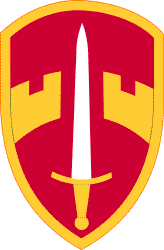MACV
| U.S. Military Assistance Command, Vietnam | |
|---|---|

U.S. Military Assistance Command, Vietnam
shoulder sleeve insignia |
|
| Active | 1962–73 |
| Country |
|
| Part of | United States Pacific Command |
| Garrison/HQ | Tan Son Nhut Air Base, South Vietnam |
| Nickname(s) | "MACV" |
| Decorations | Gallantry Cross (Vietnam) with Palm |
| Battle honours |
|
| Commanders | |
| Notable commanders |
Paul D. Harkins William C. Westmoreland Creighton W. Abrams Frederick C. Weyand |
U.S. Military Assistance Command, Vietnam (MACV) was a joint-service command of the United States Department of Defense.
MACV was created on 8 February 1962, in response to the increase in United States military assistance to South Vietnam. MACV was first implemented to assist the Military Assistance Advisory Group (MAAG) Vietnam, controlling every advisory and assistance effort in Vietnam, but was reorganized on 15 May 1964 and absorbed MAAG Vietnam to its command when combat unit deployment became too large for advisory group control. MACV was disestablished on 29 March 1973.
The first commanding general of MACV (COMUSMACV), General Paul D. Harkins, was also the commander of MAAG Vietnam, and after reorganization was succeeded by General William C. Westmoreland in June 1964, followed by General Creighton W. Abrams (July 1968) and General Frederick C. Weyand (June 1972).
Major component commands of MACV were:
In contrast to the carrier, amphibious, and naval gunfire support forces and, at least during early 1965, the coastal patrol force, which Commander Seventh Fleet directed, the Navy's forces within South Vietnam were operationally controlled by COMUSMACV. Initially, General William C. Westmoreland exercised this command through the Chief, Naval Advisory Group. However, the increasing demands of the war required a distinct operational rather than an advisory headquarters for naval units. As a result, on 1 April 1966, Naval Forces, Vietnam, was established to control the Navy's units in the II, III, and IV Corps Tactical Zones. This eventually included the major combat formations: Coastal Surveillance Force (Task Force 115), River Patrol Force (Task Force 116), and Riverine Assault Force (Task Force 117). The latter unit formed the naval component of the joint Army-Navy Mobile Riverine Force. Commander Naval Forces, Vietnam (COMNAVFORV) also controlled the Naval Support Activity, Saigon (NSA Saigon), which supplied naval forces in the II, III, and IV Corps areas. Naval Support Activity Danang, provided logistic support to all American forces in the I Corps area of responsibility, where the predominant Marine presence demanded a naval supply establishment. NSA Danang was under the operational control of Commander III Marine Amphibious Force.
...
Wikipedia
